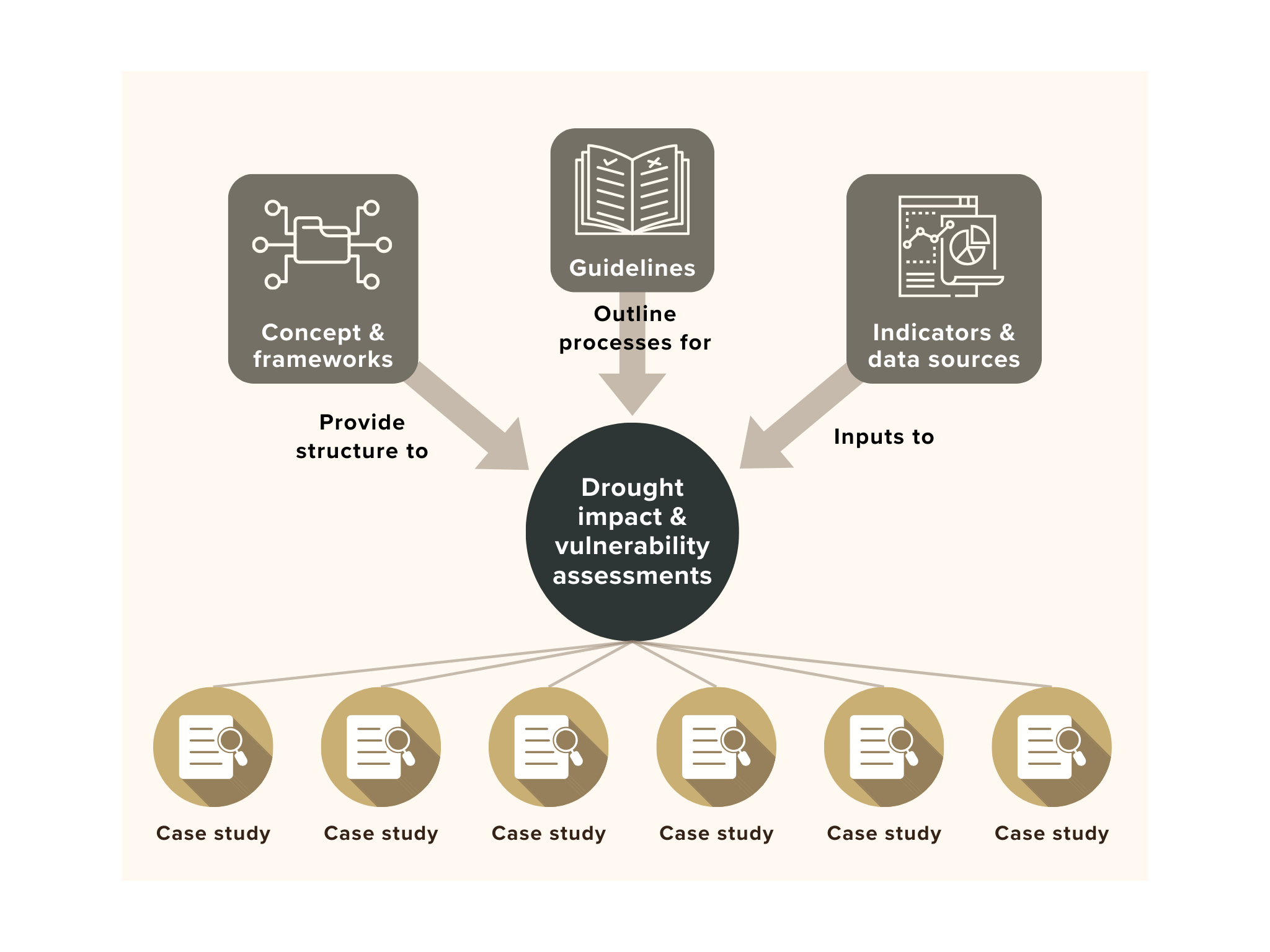
Conducting an impact and vulnerability (I&V) assessment is an evolving process, continuously being improved as new information and developments are realized. It is essential to have awareness and knowledge of the conceptual changes that the drought I&V assessment has undergone to build common understanding and a consistent use of the terminologies.
Evolution and definitions of impact and vulnerability assessment in the three pillars of integrated drought management
Integrated drought management adopts the three-pillar approach prepared by the Integrated Drought Management Programme and partners. The three pillars are the following:
- monitoring and early warning;
- impact and drought risk assessment; and
- risk mitigation, preparedness, and response.
Instead of a rigid definition and interpretation, the international community suggests a more flexible and evolving application of these pillars. This flexibility reflects the rapidly evolving science of drought.
One of the notable changes is the transformation of pillar 2 from ‘impact and vulnerability assessment’ to a more holistic definition called ‘impact and risk assessment’. This is partly the result of the efforts to align drought risk management with climate disaster risk reduction.
There are further technical reasons for the transformation that make the new definition of pillar 2 more cohesive and explicit to drought. While impact assessment remains an individual component of pillar 2, vulnerability became a part of the risk assessment component as the following:
HAZARD x EXPOSURE x VULNERABILITY = DROUGHT RISK
The three sub-components of drought risk are layered on each other and assessed in conjunction. The combined use ensures that the assessment is performed only in areas with a credible and evidence-based possibility of drought events. As a result, vulnerability assessments that previously expressed systems' overall socio-economic and environmental vulnerability become drought-specific. According to the UNCCD’s Good practice guidance for national reporting on UNCCD strategic objective 3, the recommended definition and calculation of the sub-components is the following:
- hazard: trends in the proportion of land area under drought over the total land area, using the standardized precipitation index or the standardized precipitation evapotranspiration index as its indicator for computing;
- exposure: trends in the proportion of the total population exposed to drought, using the percentage of the population exposed to different levels of drought hazard intensity as its indicator for computing;
- vulnerability: trends in the degree of drought vulnerability, computed using multiple indicators.
The compendium borrows the above definitions to align with the international guidelines. When a comprehensive and extensive impact and risk assessment is conducted, the calculation, and more precisely the applied indicators of the definitions, can be slightly modified, and this broad interpretation is particularly important in the case of vulnerability. According to the guidance, vulnerability is calculated as a composite indicator that includes baseline indicators across different dimensions.
- Literacy rate (% of people aged 15+)
- Rural population (%)
- Life expectancy at birth (in years)
- Population aged 15-64 (%)
- Government effectiveness
- Refugee population (%)
- Proportion of the population below the international poverty line
- GDP per capita
- Agriculture % of GDP
- Energy consumption per capita
- The proportion of the population using safely managed drinking water services
- Total renewable water resources per capita.
- Cultivated area equipped for irrigation
Vulnerability often goes beyond these baseline indicators and requires the investigation of further factors to depict an accurate representation. A rigorous vulnerability assessment must be tailored to the local contexts and supported by a mix of various indicators. This complexity is the first reason why the compendium focuses only on vulnerability from the drought risk equation, apart from the impact assessment.
The other reason is that vulnerability can be managed, reduced or eliminated through human interventions, while hazard and exposure cannot be. Therefore, if planning for drought management aims to mitigate the impacts as a principal strategy, the impact-vulnerability interaction must be explored.
Support for planning – To reduce the risks of systems to drought, planning for the implementation of proactive drought management is necessary. One critical step is the conduct of comprehensive impact and vulnerability assessments to:
- identify past drought impacts and utilize the analysis to plan action for future impacts;
- map out the vulnerable sectors, populations, and areas that may be impacted by future drought events; and
- effectively help understand the causes of drought vulnerability.
Addressing knowledge gaps – Despite the urgency, many countries still lack drought vulnerability assessments (DVA), let alone combined I&V assessments. Existing reports often fall short in scope and details. Although most countries recognize the relevance of a combined I&V assessment and the importance of developing tools and mechanisms to support its development, the lack of ‘know-how’ in performing I&V assessments remains an open challenge.
The knowledge gained from the Compendium aims to address this gap. The Compendium intends to inspire and support country decision-makers, planners, and professionals in preparing and completing an effective I&V assessment, paving the way for informed action in drought risk management.

Glossary of the Compendium
Hazard: trends in the proportion of land area under drought, characterizing location, intensity and likelihood of occurrence.
Exposure: trends in the proportion in areas with presence of livelihoods at different intensities of drought hazard.
Vulnerability: high-level factors of social, economic and infrastructural indicators which are necessary for communities or systems to withstand drought hazards without irreversible changes in state and functions.
Risk: the combination of hazard, exposure and vulnerability to drought.
Impact: direct and indirect, positive and negative effects of drought on systems.
